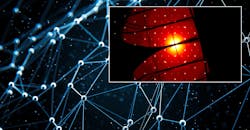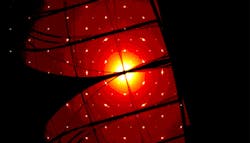Topological Material Shows Unusual Behavior
In recent years, scientists have become intrigued by topological materials, those that show unusual and split behavior. They can have different properties at their surface than in their bulk. This behavior has gotten the attention of engineers interested in new states of matter and potential electronic and spintronic applications. At Argonne National Laboratory, for example, researchers created a new class of topological materials made by inserting transition metal atoms into the atomic lattice of niobium diselenide (NbS2), a well-known two-dimensional material. They found that CoNb3S6, an antiferromagnetic material, exhibits an extremely large anomalous Hall effect, a sign of topological materials.
The ordinary Hall effect is present in all electrical conductors. The effect is essentially a force on an electron as it moves through a magnetic field. “In every metal, electrons get pushed perpendicular to their direction of travel and perpendicular to an applied external magnetic field, creating a voltage,” says Nirmal Ghimire, a professor at George Mason University and a recent Argonne researcher. “If the material is a ferromagnet, an additional contribution gets superimposed on the ordinary Hall voltage; this is known as the anomalous Hall effect (AHE).”
This shows X-ray diffraction on a single crystal of an antiferromagnetic material. This material, scientists found, exhibits an extremely large anomalous Hall effect, a sign of its topological character. (Image by Argonne National Laboratory)
In the study, Ghimire and his colleagues looked at CoNb3S6 and found something unexpected: a large AHE in modest magnetic fields. “An AHE can also be found in materials where the electronic structure has special characteristics known as topological features,” Ghimire explains. “The configuration of atoms in the lattice creates symmetries in the material that lead to the creation of topological bands—energy regions that electrons inhabit. It is these bands, in certain configurations, that lead to exceptionally large AHEs.”
Based on calculations and measurements, Ghimire and his colleagues suggest that CoNb3S6 contains these topological bands.
The topological features arise from a combination of the symmetry of the material and the right electron concentration that puts these topological features at the Fermi level, which is the highest available electronic energy state at zero temperature. Only a handful of materials have been shown to have the necessary characteristic topological points near the Fermi level. To find more requires an understanding both of the materials physics and chemistry at play.
This discovery could pave the way for future advances in a broad class of materials because it gives researchers a design rule for making materials that demonstrate these topological properties. CoNb3S6 is a member of a large class of layered two-dimensional materials, so this might open the door to many new examples of topological matter.New Vapor Deposition Method Lets Engineers Build Untraditional Materials


